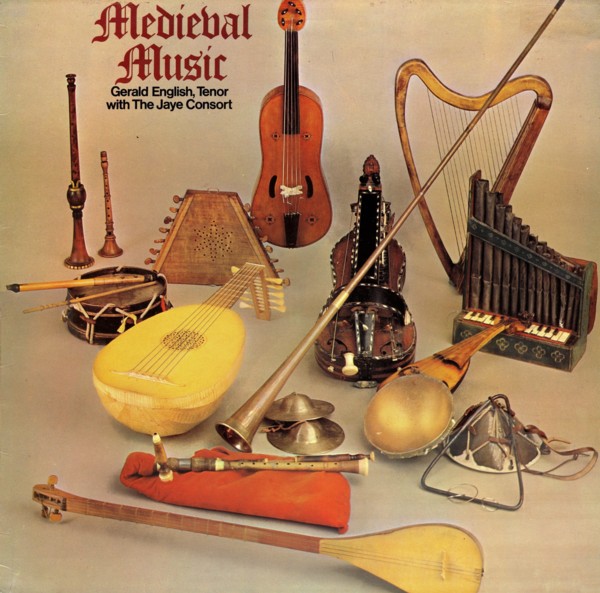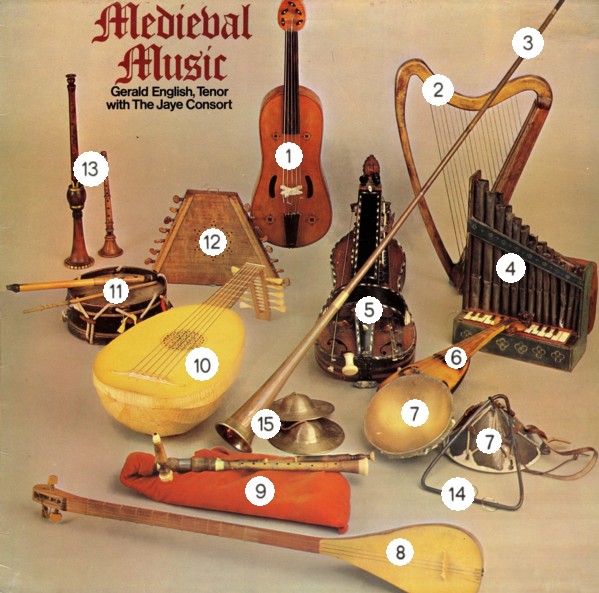Popular Medieval Music / Gerald English & The Jaye Consort
The Jaye Consort have here abandoned their viols (made by Henry Jaye,
c. 1620) to play medieval music on reconstructed medieval instruments
— all of which are depicted on the cover. The result is a
heterophony, not unlike an Arabian night-club band, but nothing has
been added to the music apart from drones, divisions, and a variety of
percussion.

«This LP has been a reference for many in the late 60's as an introduction to medieval music,
a sort of "best of ...", when you read the selection»
medieval.org
Pye «Golden Guinea Collector» GSGC 14092 (LP, stereo)
1967p.
Gerald English, tenor,
with the Jaye Consort
Popular Medieval Music
The Minstrels: Minstrels Tunes.
Songs and Dances of the Middle Ages on Authentic Instruments
01 - The Song of the Ass [3:00]
This is from a play given at Beauvais in the twelfth century and whilst
it was sung a young girl representing the Virgin Mary, with a child in
her arms rode an ass into the Cathedral and up to the altar.
02 - Ductia [1:37]
Little is known regarding the origin of this dance except that it
probably dates from the thirteenth century.
03 - English dance [1:33]
Also from the thirteenth century, this piece is played on the medieval
fiddle which is both larger in size and lower in pitch than the modern
viola.
04 - Rege mentem [1:40]
A fine example of thirteenth century "conductus", or song.
05 - Saltarello [1:01]
From the fourteenth century, this fine piece is played on the
cornemuse, a variety of bagpipes.
06 - Estampie [1:32]
Written for, and played on the organ. It may be the earliest known
example of keyboard music, and contains much hocket (hiccough) —
a style of writing much favoured at the time. It was taken from the
Robertsbridge manuscript of c.1325.
07 - Li mans d'amer [1:40]
This is a beautiful unaccompanied ballade by Adam de la Halle, from the
thirteenth century.
08 - Lamento di Tristan [3:43]
A melody from the fourteenth century — to which we have added the
long-necked lute with metal strings, and nakers, which resemble very
small timpani.
09 - Estampie [1:23]
The main form of dance of the thirteenth century, incorporating the
nasal-sounding rebec.
10 - C'est la fin [an. trouvère] [2:31]
A Trouvère song (virelai) in which the Breton bombardt, a little
outdoor shawm will be heard.The words —"It is the end. No matter
what is said, I must love".
11 - Estampie [1:38]
Like the preceding estampie, this is to be found in the famous "Sumer
is icumen in" manuscript.
12 - Kalenda Maya [1:44]
A wonderfully exhilarating song by the famous thirteenth century
troubador Raimbault de Vaqueiras.
SIDE TWO
01 - Ductia [1:06]
A thirteenth century French piece played on the three-holed pipe and
Tambour de Béarn, which is a string drum.
02 - Novus miles sequitur [2:33]
Another example of "conductus", reflecting on the death of Thomas
Becket — "The new soldiers follow the way of the new King".
03 - Moulin de Paris [2:16]
From the thirteenth century, played on the hurdy-gurdy, known in the
Middle Ages as the symphony. It is a string instrument with a rotating
wooden wheel in place of a bow and a small keyboard.
04 - In seculum artifex [1:51]
Here we have a lilting melody from the thirteenth century.
05 - Sol ovitur [2:06]
An unaccompanied song from the thirteenth century. The long melismas
are original.
06 - Vierhundert jar uff diser Erde [0:56]
Another example of early organ music taken from the Buxheimer Orgelbuch
of the fifteenth century. The quaint spelling of the title is from the
original.
07 - Trotto [0:55]
A very lively English dance from the fourteenth century.
08 - Worldes blis [2:20]
From the thirteenth century "The world's joy lasts no time at all, for
it fades away at once. All the joy both here and there is finally
encompassed by weeping and lamentation."
09 - Alta [1:53]
This is a Basse dance, C.1500 and is played on the viols.
10 - Ja nun hons pris [1:04]
This was composed by Richard Coeur de Lion whilst in captivity. He
complains that his friends may not pay his ransom. It is accompanied on
the minstrel's harp.
11 - Die suss Nachtigall [1:30]
Another organ piece taken from the Buxheimer Orgelbuch.
12 - Pour mon coeur [1:46]
A Trouvère song (Rotrouengl). "I sing of a comely lass who has
captured my heart. If only that cuckold of a husband would get his arms
broken, I might find more favour with her."
13 - Estampie Royale [1:49]
A rousing thirteenth century dance. It includes the shawm and the
medieval trumpet, played as such instruments are played to this day in
Tibet.
FRANCIS BAINES

1. Medieval Fiddle
2. Minstrel's Harp
3. Medieval Trumpet
4. Portative Organ
5. Hurdy Gurdy
6. Rebec
7. Nakers
8. Long-necked Lute
9. Cornemuse
10. Medieval Lute
11. Pipe & Tabor
12. Psaltery
13. Shawns
14. Medieval Triangle
15. Medieval Cymbals

